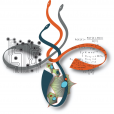Models of sequence evolution: gene evolution and cancer
M Hallett
21/07/2020
Goals for today
Using Markov models for sequence evolution
Nucleotide substitution models
Amino acid level models
Point Accepted Mutations (PAM)
Other evolutionary events
Relationship to cancer
Points of reflection
In our models, we used steps in our Markov model as a unit of time. More precisely, we “calibrated” the MMs so that they match with an expected number of mutations at the site. What are some of the problems of using time directly in the models?
Make sure you understand the difference between a mutation and a point mutation?
- Regardless of the environment or type of organism or the environment it is living in, does the mutation rate (not accepted mutation rate, but the mutation rate) change? What influence would the cell cycle of the organism have on the notion of time?
How does the environment an organism is living in affect selection?
BIOL 480
© M Hallett, 2020 Concordia University

1
Models of sequence evolution: gene evolution and cancer
M Hallett
21/07/2020

